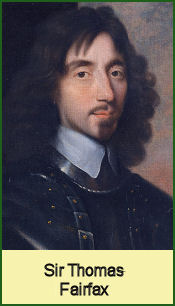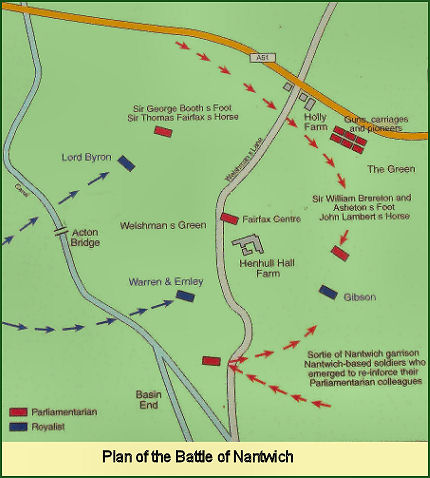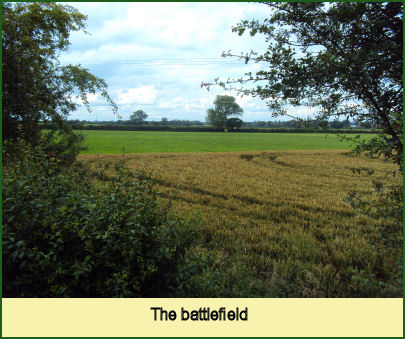The Battle of Nantwich
 The Battle of Nantwich proved to be a decisive victory for the Parliamentarians in The English Civil War (1642-1646). Nantwich was then Cheshire's second major town and of importance due to its strategic position on the road to Chester.
The Battle of Nantwich proved to be a decisive victory for the Parliamentarians in The English Civil War (1642-1646). Nantwich was then Cheshire's second major town and of importance due to its strategic position on the road to Chester.
 By the closing months of 1643, Royalist forces (Cavaliers) had secured all of Cheshire with the exception of the town of Nantwich, which had been a Parliamentarian (Roundhead) garrison since January 1643 and was holding out under siege.
By the closing months of 1643, Royalist forces (Cavaliers) had secured all of Cheshire with the exception of the town of Nantwich, which had been a Parliamentarian (Roundhead) garrison since January 1643 and was holding out under siege.
The parliamentary commander, Sir Thomas Fairfax was sent to relieve of the town, marching with around 5,000 troops from Lincolnshire, he joined Sir William Brereton at Manchester with a combined force of around 3,000 foot and 1,800 horse from Lancashire, Cheshire and Yorkshire. Nantwich was important to Parliamentary cause, there were numerous English soldiers based in Ireland who were loyal to King Charles I and the Royalist cause. If they were to be landed anywhere to support the Royalists in the north, it would be at nearby Chester.
Nantwich was to be the first civil war battle of 1644 and was fought on the 25th January. In the seventeenth century Nantwich was not much more than a large village by todays standards, it lay on the the River Weaver, which normally was a stream of around 20 feet (6.1 m) wide.
By the time Fairfax arrived at Nantwich, he discovered that the Royalist force stationed there had been reduced due to the bad weather. He probably faced no more than 2,400 foot and less than 1,000 horse. After holding a Council of War, Fairfax decided to fight just outside of Nantwich where his horse would be more effective.
 The winter of 1643/44 was a hard one and the surrounding landscape was blanketed in snow. The Chester Road bridge in the town was controlled by the parliamentarians but the Royalists could cross the river by means of a bridge at Beam Bridge, a short distance to the north. Byron's headquarters were at the nearby village of Acton, to the west, a distance of about a mile away. His forces were quartered in a circle around the town.
The winter of 1643/44 was a hard one and the surrounding landscape was blanketed in snow. The Chester Road bridge in the town was controlled by the parliamentarians but the Royalists could cross the river by means of a bridge at Beam Bridge, a short distance to the north. Byron's headquarters were at the nearby village of Acton, to the west, a distance of about a mile away. His forces were quartered in a circle around the town.
Fairfax's Parliamentarians defeated a small Royalist force on the 24th January which had attempted to block the road to Nantwich at Delamere Forest. Byron was intent on holding the siege, but the following day brought a sudden thaw which resulted in the River Weaver rising dramatically. He accordingly moved his forces to the drier ground to the west bank of the river around Acton, but the bridge at Beam Bridge was swept away by the floodwaters leaving the Royalists stranded on the east bank. He therefore had no choice but to make a march of 6 miles to reach another crossing at Minshull Vernon to support his infantry at Acton.
As Fairfax's forces marched on Acton, Colonel Richard Gibson deployed four Royalist regiments of infantry to meet them, attacking in the early afternoon. Fairfax was aware that Byron's forces were also approaching from nearby Minshull Vernon, but he deployed only two regiments of infantry and his own troop of cavalry to face them, while the main body of the Parliamentary army remained to face Gibson's forces. Gibson's troops repelled the first Parliamentary attack but the Parliamentarian cavalry outflanked the Royalist right wing and forced it into retreat. The Royalist centre broke and also retreated. The Royalists fell back to Acton church where Colonel Gibson surrendered to Fairfax under terms. The artillery and baggage train were captured and about 1,500 officers and men taken prisoner.
Many Royalist soldiers defected to the Parliamentarian side, while the remainder surrendered or fled the battlefield. About 1,500 were taken prisoner. Many of the officers took refuge in Acton Church, and were also taken prisoner after surrendering on terms. Lord Byron himself retreated to Chester.
 The battle marked a significant victory for the parliamentarians. Nantwich was relieved, the royalist domination of Cheshire was smashed, the royalist artillery and the baggage train was captured and several senior royalist officers taken prisoner.
The battle marked a significant victory for the parliamentarians. Nantwich was relieved, the royalist domination of Cheshire was smashed, the royalist artillery and the baggage train was captured and several senior royalist officers taken prisoner.
The victory was to mark the beginning of the recovery of the parliamentarian cause in the North of England. It also served to enhance the military reputation of Sir Thomas Fairfax and made him an obvious choice as commander-in-chief of the New Model Army a year later, the formation of which led to ultimate victory for Parliament.
To celebrate the victory people wore sprigs of holly in their hair and hats. Today the battle is commemorated every year in Nantwich on the nearest Saturday to the original battle date, the celebration is known as Holly Holy Day. The Nantwich Holly Holy Day Society hold a wreath laying ceremony at the war memorial in the town square followed by a parade through the town of Royalist and Parliamentary troops. A re-enactment of the battle then takes place at Mill Island close to the town centre.
The battlefield remains largely enclosed pasture, as it was in 1644, however, the Shropshire union canal has cut across the very heart of the battlefield. The canal bridge at Acton provides a particularly good viewpoint over the battlefield. Many of the buildings used during the time still exist today, the Royalist headquarters were at nearby Acton church , which overlooks the battlefield and visitors can still see evidence of the battle in the form of musket shots which are clearly visible in the south transept of the building. The Lamb's Hotel building (now known as Chatterton House) on Hospital Street in Nantwich was the headquarters of the Parliamentarians, while St. Mary's church in the town was used as a prison by the Parliamentarians. An original letter from Sir Thomas Fairfax and Battle of Nantwich artefacts can be seen at Nantwich Museum which is located on Pillory Street.
Further Civil War reading
The Civil War Massacre of Barthomley and skirmish at Haslington
